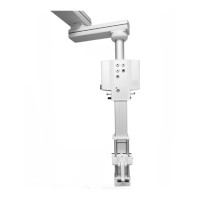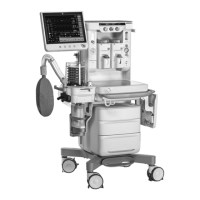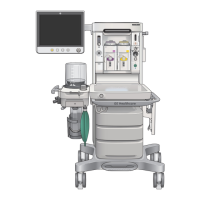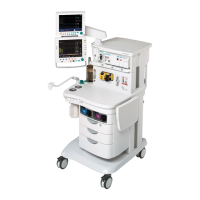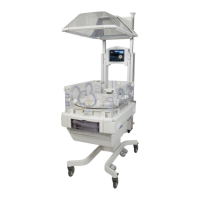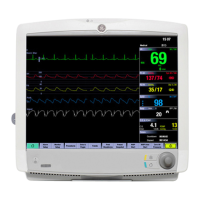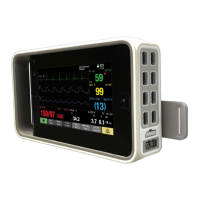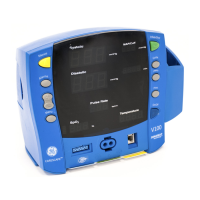1. Auxiliary O2, 0-10 l/min, optional 38. Mechanical overpressure valve, 110 cmH2O
2. Pipeline: O2, Air, N2O 39. Free breathing check valve
3. Shuttle valve 40. Atmosphere
4. Cylinder: O2, Air, N2O 41. Bellows housing
5. Venturi drive gas connection 42. Bellows
6. Vent drive gas select 43. Pop-off valve
7. O2 flush 44. Exhalation, 2.0 cmH2O bias
8. Microswitch 45. Vent engine manifold pressure
9. Gas control module 46. 200 ml reservoir
10. Air flow sensor 47. Bleed resistor
11. O2 flow sensor 48. Vent to ambient
12. N2O flow sensor 49. Bag/Vent switch
13. Filter 50. Bag
14. Air selector valve 51. APL valve, 0.5 - 70 cmH2O
15. N2O selector valve 52. Negative pressure relief valve
16. O2 secondary regulator 53. Absorber canister
17. O2 bypass valve 54. CO2 bypass
18. O2 latching valve 55. Inspiratory flow sensor
19. Balance regulator 56. Inspiratory check valve
20. Needle valve 57. O2 cell
21. Link-25 58. Expiratory check valve
22. Total flowmeter, 0 - 10 l/min 59. Expiratory flow sensor
23. Auxiliary O2+Air (optional) 60. Inspiratory flow transducer
24. Selectatec
™
Manifold, two vaporizer option 61. Expiratory flow transducer
25. Vaporizer 62. Paw transducer
26. Air regulator, optional, 30 psi 63. Patient Y or patient connection
27. ACGO, optional 64. Gas monitor
28. Mechanical overpressure valve, 110 cmH2O 65. Default factory connection
29. ACGO outlet port, optional 66. Passive AGSS
30. ACGO transducer, optional 67. Relief valve, -0.3 cmH2O
31. Vent engine 68. Relief valve, 10 cmH2O
32. Filter 69. To disposal system
33. Drive gas inlet valve 70. Active AGSS, High vacuum
34. Regulator, 25 psi (15 LPM) 71. Reservoir
35. Inspiratory flow control valve 72. To pressure sensor in ACB
36. Drive gas flow sensor 73. Active AGSS, Low vacuum, BSI 30mm, SIS EVAC,
DISS and 25 mm BARB
37. Drive gas check valve, 3.5 cmH2O bias 74. Active AGSS, Other low vacuum
Figure 11-1 • System pneumatic diagram
Gas supplies
Pressurized gas supplies enter the system through a pipeline or
cylinder connection. All connections have indexed fittings, filters, and
check valves.
A regulator decreases the cylinder pressures to the appropriate
system pressure. A pressure relief valve helps protect the system
from excessive high pressures.
11 Specifications and theory of operation
2076152-001 11-3

